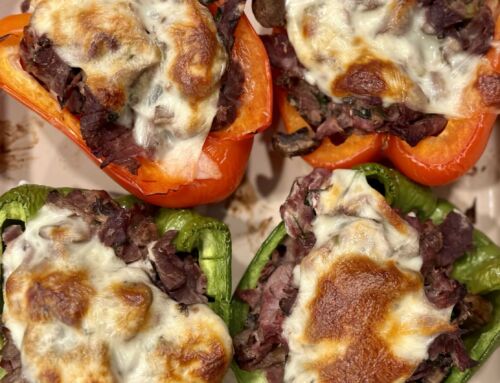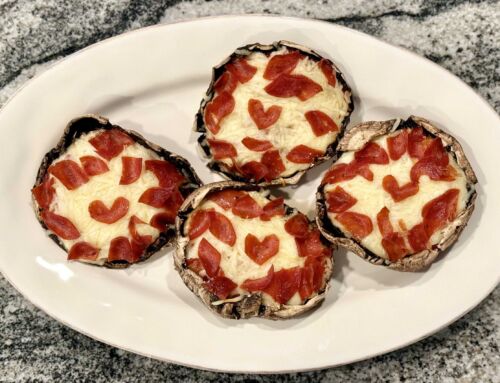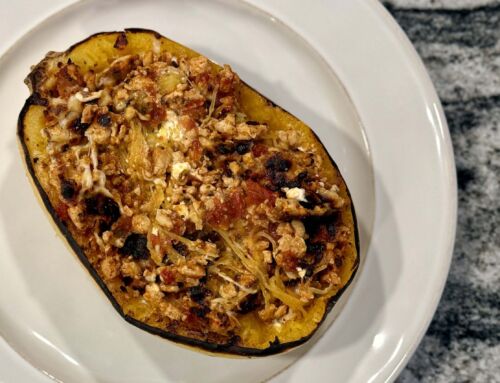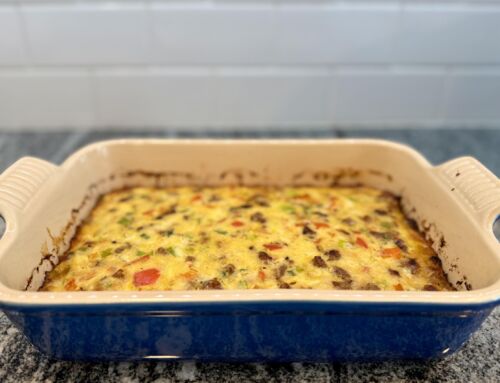This pork dish comes from Ikaria (or Icaria), a Greek island in the eastern Mediterranean. Its name is derived from Icarus, from Greek mythology. He was given wings made of feathers and wax by his father and warned not to fly too close to the sun. When Icarus did, the wax melted and he fell into the sea, not far from the island that bears his name. While I was familiar with the myth of Icarus, I was not familiar with the island.
This dish is a wonderful balance of sweet and savory so often found in Greek cuisine. ‘Balance’ is the key word as it has just the right amount of sweetness and pairs well with the pork. The sweetness comes from honey and oranges. The recipe calls for a strong and dark honey, such as buckwheat, but you can use a more mild honey, such as orange blossom honey. I have a large honey supply as I like to pick up local honey when I see it (don’t even get my husband started on this!) but I didn’t have any dark honey. Instead I used a light honey from the Adirondacks in upstate New York. It worked perfectly.
I used boneless country pork ribs but you can also use boneless pork shoulder. Both benefit from long and low temperature cooking – in the end the meat is very tender. This recipe calls for browning most of the pork and combining it with the pork that was not browned. The result was that the browned meat became very tender and held together fairly well, while the rest of the meat fell apart. It provided a nice contrast.
Since this dish cooks in the oven for two to two and a half hours, the rest of the ingredients, such as the onions, cook down so nicely. Please do not skimp on the fennel seeds – use the full tablespoon. It’s not like sweet Italian sausage where you often come across a whole fennel seed. Here they break up and melt into the sauce.
This dish is perfect for making on a Sunday afternoon when you have time. It takes about four hours total but much of that is time in the oven. You want the meat to be tender, so I do not recommend rushing this step. I made it earlier in the day and found myself going back for a nibble or two because the flavors were so good. I was very excited when it was finally time for dinner.
This recipe feeds six to eight. Since I was just preparing it for Ed and me, I divided the remaining pork into two and froze it for future meals. Something sweet and savory to look forward to.
| Greek Braised Pork | Print |
- 5 to 6 pounds or boneless country pork ribs or boneless pork shoulder, trimmed, cut into 2-inch pieces and patted dry
- ¼ cup olive oil
- 1 large red onion, halved and thinly sliced
- 1 cup dry white wine
- 2 tablespoons minced fresh rosemary, divided
- 3 bay leaves
- 2 teaspoons dried oregano
- 1 tablespoon fennel seeds
- ½ cup honey, divided (see Notes)
- 1 tablespoon grated orange zest (~ 1 orange)
- ½ cup orange juice (~ 2 to 3 oranges) (see Notes)
- 3 tablespoons finely chopped fresh oregano
- 2 tablespoons apple cider vinegar
- Kosher salt and ground black pepper
- Heat the oven to 325°F with a rack in the middle position.
- Season the pork with salt and pepper.
- In a large (at least 7-quart) Dutch oven over medium-high heat, heat the oil.
- Set aside about ¼ of the pork. Brown the remaining pieces of pork in batches (it took me 4 batches). Add pork pieces in an even layer (be careful not to crowd them) and cook without stirring until well browned, about 7 minutes. Using tongs, flip the pieces and cook without stirring until well browned on the second side, about 5 minutes. Transfer to a medium bowl and repeat until you’ve browned about ¾ of the pork, adding more oil if needed. Add the remaining ¼ pork to the bowl – it does not need to be browned.
- Reduce the heat to medium and add the onion and ¼ teaspoon Kosher salt to the pot. Cover and cook, stirring occasionally, until softened, about 3 to 5 minutes.
- Add the wine and cook, scraping up any browned bits, until most of the liquid has evaporated, about 5 minutes.
- Stir in 1 tablespoon rosemary, bay leaves, dried oregano, fennel seeds and ¼ cup honey.
- Return the pork and any juices to the pot, pour in ¾ cup water, and stir.
- Cover, transfer to the oven and cook until a skewer inserted into a piece of pork meets no resistance, about 2 to 2-1/2 hours. Check at 2 hours and cook longer if needed (2-1/2 hours was just right for the braise I made).
- Using a slotted spoon, transfer the pork to a large bowl and cover to keep warm (if you’re not eating it immediately, there’s no need to cover).
- Tilt the pot to pool the cooking liquid to one side, then use a wide spoon to skim off and discard as much fat as possible.
- Stir in the orange juice and remaining ¼ cup honey. Bring to a boil over high heat, then reduce to medium heat. Cook, stirring often, until a spatula drawn through the liquid leaves a trail and the liquid has reduced by about half, about 10 minutes.
- Remove pot from heat. Stir in the orange zest, remaining 1 tablespoon rosemary, fresh oregano and vinegar.
- Return the pork to the pot and stir to coat with the sauce. Taste and season with Kosher salt and pepper.
- Serve immediately or let cool and refrigerate until ready to serve. Reheat pork over low heat, covered, for 10 to 15 minutes. Pork will keep, refrigerated, for 3 days or frozen for up to 3 months.
* Before squeezing oranges, heat it in a microwave for about 20 seconds and then rub it back and forth on the counter top. This easy two-step process results in more juice per piece of fruit.
* Recipe takes about 4 hours to prepare – it takes about 1 hour before pork goes into the oven.
Source: Variation on a recipe from Milk Street, November – December, 2019







Love the back story. Looks super yummy and very meaty. Any recommendations on what would be traditionally served with it?
Susie – Thank you! Great question – we served it with boiled potatoes as we had some to use up, but an orzo or rice pilaf would be more traditonal (I don’t have recipes for either!).
Really fabulous!!! I used bone in pork – nice spare ribs which I’d planned to grill but when the Sunday turned out cool and rainy I stumbled upon your post as an alternative. Great luck for me. I made about a half recipe.
Bone in is claimed to have more flavor and may be more traditional to the old ways in Greece? But the primary issue is that it really turned out well and I’m very happy to have found this recipe. Thanks!
Jp – Glad that the dreary weather led you to this recipe and so glad you liked it! I agree that the bone-in version is likley more traditional.
It does go really well with rice, braised beans and greens.
Jp – Great suggestion – thank you for sharing.